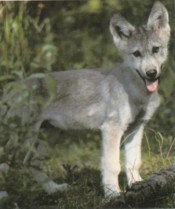 Wolves WolvesWolf History, Conservation, Ecology and Behavior
[www.wolfology.com]
|
Genetic Evidence for An East Asian Origin of Domestic Dogs
Savolainen, P.; Zhang, Y.; Luo, J.; Lundeberg, J.; Leitner, T., Science, 298 (22 November 2002), 1610
The origin of the domestic dog from wolves has been established, but the number of founding events, as well as where and when these occurred, is not known. To address these questions, we examined the mitochondrial DNA (mtDNA) sequence variation among 654 domestic dogs representing all major dog populations worldwide. Although our data indicate several maternal origins from wolf, >95% of all sequences belonged to three phylogenetic groups universally represented at similar frequencies, suggesting a common origin from a single gene pool for all dog populations. A larger genetic variation in East Asia than in other regions and the pattern of phylogeographic variation suggest an East Asian origin for the domestic dog, ~15,000 years ago.
 A Genetic Investigation of Enzyme Polymorphisms Shared by Wolf and Dog: Suggestions for Conservation of the Wolf in Italy
Lorenzini, R; Fico, R, Acta Theriologica, Suppl. 3, 1995, 101-110
In order to provide suggestions for conservation and management of the wolf...in Italy, a total of 46 wolves from central Italy and 53 mongrel dogs were surveyed for electrophoretic variation within and among populations. Six out of 41 presumptive gene loci exhibited polymorphism in the wolf, whilst only 3 loci were variable in the dog. Expected average heterozygosity in the Italian wolf was comparable to values reported previously for protein variation in natural wolf populations. By contrast, the dog showed a comparatively low heterozygosity, which may be a consequence of domestication. Nei's (1978) absolute genetic distance between wolf and dog was very similar to values reported in previous investigations, thus confirming that they are closely related forms. Relative genetic differentiation between wolf and dog was considerably higher than the mean genetic diversity found among several dog breeds. The results of the present genetic investigation on the wolf population from central Italy suggested that its genetic resources are quite intact. The extent of differences in allelic frequencies at loci polymorphic both in wolf and dog did not suggest substantial wolf-dog interbreeding, which had been thought to be one of the major threats to the genetic integrity of the Italian wolf population.
 A GPS-Based Method to Examine Wolf Response to Loud Noise
Merill, S.B.; Erickson, C.R., Wildlife Society Bulletin, 31/3 (Fall 2003), 769
We used Global Positioning System (GPS) telemetry data to examine responses of a breeding male and 2 yearling wolves (Canis lupus) to military firing at Camp Ripley National Guard Training Site in Little Falls, Minnesota. Two of 3 wolves showed movements toward firing points more often than expected. Movements toward firing points were more f requent when wolves were <5 km from the firing point before firing began. The breeding male moved toward firing points more often than the 2 yearlings. The method developed in this study could be useful for identifying tolerance thresholds in other wildlife species and for determining whether thresholds change when animals adjust to human activities.
 Growth, Survival, and Productivity of a Colonizing Wolf Population in Wisconsin
Wydeven, A.P.; Wiedenhoeft, J.E.; Schultz, R.N.; Kohn, B.E., World Wolf Congress 2003
Wolves recolonized the state of Wisconsin in the mid-1970s after being extirpated for about 15 years. Between 1979 and 2002, the Wisconsin Department of Natural Resources (WDNR) maintained constant monitoring of the state wolf population through live-trapping and radio tracking, winter track surveys, summer wolf howls, and public reports. The wolf population in Winsconsin ranged from a low of 15 (1985) to 327+ in 2002, and ranged from 4 to 83 packs. Mean estimated pup survival from late gestation to about 9 to 11 months was 0.30 (range 0.16 to ).57). During periods of disease outbreak of Parvovirus (mid 1980s), and initial outbreak of Sarcoptic mange (early 1990s), pup survival declined to <0.20. Mean pack size was 3.7 wolves, but declined to <3.0 during periods of severe disease outbreak. A mean of 36% of packs had no surviving pups in late winter. Survival of older wolves (1+yr) was 0.61 during the early 1980s when wolves declined, but increased to 0.82 in the late 1980s and early 1990s, and has remained high in recent years. Since 1985 the wolf population increased an average of 20% annually, and experienced a slight decline during only one year. Areas occupied by wolf packs expanded from about 1500km2 in the early 1980s to about 13,000km2 in 2002. The wolf population continues to increase, but growth may decline or stabilize soon as most suitable habitat is occupied, and more liberal lethal controls are enacted.
|
